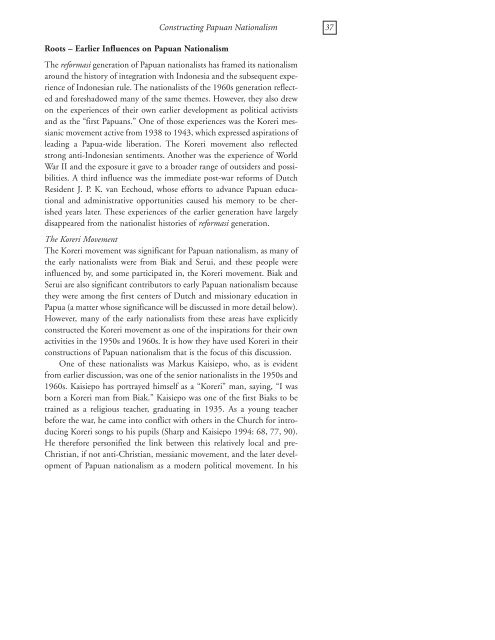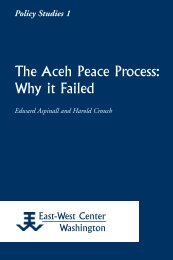Constructing Papuan Nationalism: History, Ethnicity ... - ScholarSpace
Constructing Papuan Nationalism: History, Ethnicity ... - ScholarSpace
Constructing Papuan Nationalism: History, Ethnicity ... - ScholarSpace
- No tags were found...
Create successful ePaper yourself
Turn your PDF publications into a flip-book with our unique Google optimized e-Paper software.
Roots – Earlier Influences on <strong>Papuan</strong> <strong>Nationalism</strong><strong>Constructing</strong> <strong>Papuan</strong> <strong>Nationalism</strong> 37The reformasi generation of <strong>Papuan</strong> nationalists has framed its nationalismaround the history of integration with Indonesia and the subsequent experienceof Indonesian rule. The nationalists of the 1960s generation reflectedand foreshadowed many of the same themes. However, they also drewon the experiences of their own earlier development as political activistsand as the “first <strong>Papuan</strong>s.” One of those experiences was the Koreri messianicmovement active from 1938 to 1943, which expressed aspirations ofleading a Papua-wide liberation. The Koreri movement also reflectedstrong anti-Indonesian sentiments. Another was the experience of WorldWar II and the exposure it gave to a broader range of outsiders and possibilities.A third influence was the immediate post-war reforms of DutchResident J. P. K. van Eechoud, whose efforts to advance <strong>Papuan</strong> educationaland administrative opportunities caused his memory to be cherishedyears later. These experiences of the earlier generation have largelydisappeared from the nationalist histories of reformasi generation.The Koreri MovementThe Koreri movement was significant for <strong>Papuan</strong> nationalism, as many ofthe early nationalists were from Biak and Serui, and these people wereinfluenced by, and some participated in, the Koreri movement. Biak andSerui are also significant contributors to early <strong>Papuan</strong> nationalism becausethey were among the first centers of Dutch and missionary education inPapua (a matter whose significance will be discussed in more detail below).However, many of the early nationalists from these areas have explicitlyconstructed the Koreri movement as one of the inspirations for their ownactivities in the 1950s and 1960s. It is how they have used Koreri in theirconstructions of <strong>Papuan</strong> nationalism that is the focus of this discussion.One of these nationalists was Markus Kaisiepo, who, as is evidentfrom earlier discussion, was one of the senior nationalists in the 1950s and1960s. Kaisiepo has portrayed himself as a “Koreri” man, saying, “I wasborn a Koreri man from Biak.” Kaisiepo was one of the first Biaks to betrained as a religious teacher, graduating in 1935. As a young teacherbefore the war, he came into conflict with others in the Church for introducingKoreri songs to his pupils (Sharp and Kaisiepo 1994: 68, 77, 90).He therefore personified the link between this relatively local and pre-Christian, if not anti-Christian, messianic movement, and the later developmentof <strong>Papuan</strong> nationalism as a modern political movement. In his
















